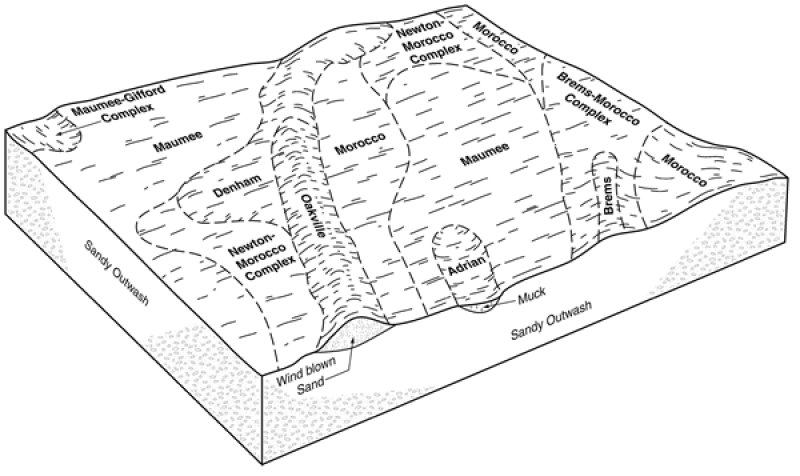
Natural Resources
Conservation Service
Ecological site F111XC003IN
Sandy Interdune
Last updated: 9/11/2024
Accessed: 12/21/2025
General information
Provisional. A provisional ecological site description has undergone quality control and quality assurance review. It contains a working state and transition model and enough information to identify the ecological site.
MLRA notes
Major Land Resource Area (MLRA): 111X–Indiana and Ohio Till Plain
A Provisional Ecological Site is a conceptual grouping of soil map unit components within a Major Land Resource Area (MLRA) based on the similarities in response to management. Although there may be wide variability in the productivity of the soils grouped into a Provisional Site, the soil vegetation interactions as expressed in the State and Transition Model are similar and the management actions required to achieve objectives, whether maintaining the existing ecological state or managing for an alternative state, are similar. Provisional Sites are likely to be refined into more precise group during the process of meeting the APPROVED ECOLOGICAL SITE DESCRIPTION criteria.
This Provisional Ecological Site has been developed to meet the standards established in the National Ecological Site Handbook. The information associated with this ecological site does not meet the Approved Ecological Site Description Standard, but it has been through a Quality Control and Quality Assurance processes to assure consistency and completeness. Further investigations, reviews and correlations are necessary before it becomes an Approved Ecological Site Description.
111C – Indiana and Ohio Till Plain, Northwestern Part. This MLRA is in the glaciated part of north-central Indiana and is dominated by glacial till plains broken in places by lake plains, outwash plains, and flood plains. Areas that parallel most of the major rivers and streams have deposits of sand.
Although it is an important agricultural region, MLRA 111C hosts a large proportion of Indiana’s biodiversity.
Classification relationships
Major Land Resource Area (MLRA)(USDA-Natural Resources Conservation Service, 2006)
USFS Ecological Regions (USDA, 2007):
Sections - Central Till Plains, Beech Maple (222H), South Central Great Lakes (222J), Central Till Plains and Grand Prairies (251D)
Subsections - Kalamazoo-Elkhart Moraines and Plains (222Jh), Steuben Interlobate Moraines (222Ji), Bluffton Till Plains (222Ha), Entrenched Valleys (222Hf), Miami-Scioto Plain-Tipton Till Plain (222Hb), Kankakee Sands (251Dg) and Eastern Grand Prairie (251Dd).
NatureServe Systems anticipated (NatureServe, 2011): Agriculture-Pasture/Hay, Agriculture-Cultivated Crops and Irrigated Agriculture, Central Interior Highlands calcareous Glade and Barrens, Central Interior Highlands Dry Acidic Glade & Barrens, Central Tallgrass Prairie, Harvested Forest-Grass Regeneration, Harvested Forest-Herbaceous Regeneration, Introduced Upland Vegetation – Treed, Laurentian-Acadian Alkaline Conifer-Hardwood Swamp, Laurentian-Acadian Northern Hardwoods Forest, Laurentian-Acadian Northern Pine-Oak Forest, Laurentian-Acadian Wet Meadow-Shrub Swamp, Laurentian Pine-Oak Barrens, Managed Tree Plantation, North-Central Interior and Appalachian Acidic Peatland, North-Central Interior Beech-Maple Forest, North-Central Interior Dry Oak Forest & Woodland, North-Central Interior Dry-Mesic Oak Forest & Woodland, North-Central Interior Floodplain, North-Central Interior Freshwater Marsh, North-Central Interior Maple-Basswood Forest, North-Central Interior Oak Savanna, North-Central Interior Sand Gravel Tallgrass Prairie, North-Central Interior Wet Flatwoods, North-Central Interior Wet Meadow-Shrub Swamp, North-Central Oak Barrens, Ruderal Forest, Ruderal Upland-Old Field, South-Central Interior Large Floodplain.
LANDFIRE Biophysical Settings anticipated (USGS, 2010): North-Central Interior Oak Savanna, North-Central Interior Sand and Gravel Tallgrass Prairie, Central Interior and Appalachian Swamp Systems, North-Central Interior Dry-Mesic Oak Forest and Woodland, North-Central Interior Dry Oak Forest and Woodland, North-Central Interior Beech-Maple Forest, North Central Oak Barrens, Central Interior and Appalachian Floodplain Systems, Great Lakes Coastal Marsh Systems, Central Interior and Appalachian Shrub-Herbaceous wetland systems, North Central Wet Flatwoods, North-Central Interior Maple-Basswood Forest, Central Tallgrass Prairie, South-Central Interior Mesophytic Forest, Boreal White Spruce-Fire-Hardwood Forest-Inland, Great Lakes Pine Barrens, Great Lakes Wet-Mesic Lakeplain Prairie, Laurentian-Acadian Alkaline Conifer-Hardwood Swamp, Laurentian-Acadian Floodplain Systems, Laurentian-Acadian Shrub-Herbaceous Wetland Systems, Laurentian Pine-Oak Barrens, Northern Sugar Maple-Basswood Forest, Paleozoic Plateau Bluff and Talus.
Ecological site concept
This site is an upland site formed in depressions on glacial till plains, land plains, on sandy parent material. It is located on the footslopes, toeslopes, and back slopes with less than 7% slope. Drainage of the soils on this site ranges from somewhat poorly drained to moderately well drained. There are 5 distinct states: 1) the oak woodland state (reference state); 2) agriculture state; 3) early successional forest state; 4) high graded state; 5) fire suppressed state. Fire intensity and frequency was the principle driver for this site, with low intensity ground fires every (4-17) years being common. Since settlement, most of this site has been converted to agriculture with the majority being row crop agriculture. The most common practice involves grain rotations between corn and soybeans.
Associated sites
| R111XC001IN |
Sand Dune Higher on the landscape and in a convex position. |
|---|---|
| R111XC002IN |
Wet Sandy Interdune Lower on the landscape and wetter. Herbaceous dominated in reference condition. |
Similar sites
| F111XC009IN |
Overflow Higher canopy cover of trees, generally exceeds 60%. |
|---|---|
| F111XC007IN |
Glacial Ridge On a convex landscape position with more mesic tree species present. |
Table 1. Dominant plant species
| Tree |
(1) Quercus velutina |
|---|---|
| Shrub |
(1) Cornus florida |
| Herbaceous |
(1) Andropogon gerardii |
Click on box and path labels to scroll to the respective text.

